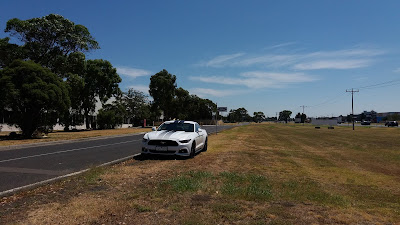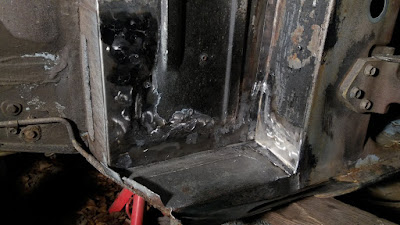 |
| Numbers matching engine block. |
I don't have exact plans what to do with the engine. Being the original block I'd like to keep it, but instead of restoring the whole engine back to factory specs I am tempted to use some more modern performance parts.
Ford Australia stamped the blocks with the same ID number than the chassis. In 'JG66NM' J is for Australia, G is for Broadmeadows plant, 66 is for model Falcon GT Coupe, N is for 1973 and M is for March. The rest of the VIN is unique serial number.
The last engine rebuild had been done by some previous owner. I was not sure what to expect. For reason unknown to me, the previous engine removal had required cutting the frame crossmember off. After it was welded back in place, the seams were left to rust.

Dismantling the engine was interesting. The block casting number is D2AE-CA, a cast that could accept 4-bolt main bearing caps. It is a good cast from Cleveland Foundry and strong enough for most applications with standard 2-bolt caps.
Now there is something strange with those main bearing caps on this engine. There appears to be two bolts and two machine screws per each cap. As said before, this cast can be machined to accept 4-bolt caps. Like this one here I found from the Internet:
 |
| Example of factory made 4-bolt main bearing caps. Source https://www.picclickimg.com/d/w1600/pict/322253979621_/Ford-351-Cleveland-4-Bolt-Engine-Block-Fully.jpg. |
It appears that my block came from the factory with standard 2-bolt main caps. Then someone working with the engine possibly thought that more bolts is simply better and instead of acquiring proper 4-bolt caps, ended up machining standard caps to accept additional screws.
I am a bit worried what this kind of modification does to the cap strength. I would be happy to go with standard caps with two bolts keeping them to the block, but now the ridges on the caps have been machined and drilled. In addition, in a real 4-bolt cap the outer bolts would be 3/8", these are more like 1/4".
As you can see from the image below, on 2-bolt caps there should be support ridges on each cap and no holes in them.
 |
| Example of standard 2-bolt main bearing caps. Source http://www.mustangtek.com/block/images/D2AE-CA_05_001.jpg. | |
I might just try to get a set of real 4-bolt main caps and have a professional machine shop to fit them over the existing bungle.
No other surprises popped up yet. Some main bearings showed worn grooves but nothing major.
The block was drilled to .030" oversize. The pistons used were Keith Black Silv-O-Lite Cast Pistons 1159. These are dished pistons, producing a bit less compression than the stock engine. Out of curiosity I calculated that the engine have had static compression at the ballpoint of 9.8:1.


























































